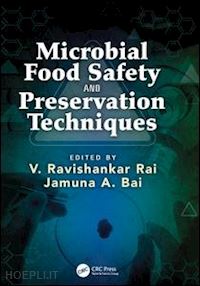Microbial Food Safety and HygieneMicrobiological Risk Assessment of Raw, Fresh Produce, Vasiliki A. Blana and George-John E. NychasListeria monocytogenes in Seafood with a Special Emphasis on RTE Seafood, Marija ZunabovicFruit Juice Processing: Addressing Consumer Demands for Safety and Quality, Alonzo A. GabrielAccumulation of Biogenic Amines in Foods: Hazard Identification and Control Options, Donatella Restuccia, Umile Gianfranco Spizzirri, Francesco Puoci, Ortensia Ilaria Parisi, Manuela Curcio, and Nevio PicciQuantitative Microbial Risk Assessment Methods for Food Safety in RTE Fresh Vegetables, G.D. Posada-Izquierdo, G. Zurera, and Fernando Pérez-RodríguezMechanisms and Risks Associated with Bacterial Transfer between Abiotic and Biotic Surfaces, Stavros G. Manios, Anastasia E. Kapetanakou, Evangelia Zilelidou, Sofia Poimenidou, and Panagiotis N. SkandamisDetection of Food-Borne PathogensMolecular Techniques for Detection of Food-Borne Bacteria and for Assessment of Bacterial Quality, Robert E. LevinRecent Developments in Molecular-Based Food-Borne Pathogen Detection, Azlin Mustapha and Prashant SinghNanobiotechnology for the Detection of Food-Borne Pathogens, Niamh Gilmartin and Barry ByrneMolecular Nanotechnology: Rapid Detection of Microbial Pathogens in Food, Swati Vyas and Vandana B. PatravaleDetection of Mycotoxin-Producing Molds and Mycotoxins in Foods, Alicia Rodríguez, María J. Andrade, Mar Rodríguez, and Juan J. CórdobaElectrochemical Biosensors for Food-Borne Pathogens, Subramanian ViswanathanNovel Techniques for Preventing Bacterial Attachment to Foods and Food-Processing Surfaces, Yi Wang and Gary A. DykesFood Preservation and Intervention TechniquesBacteriocins: The Natural Food Preservatives, Haider Khan, Steve H. Flint, and Pak-Lam YuUse of Bacteriocins and Essential Oils for the Control of Listeria monocytogenes in Processed Foods, Corliss A. O’Bryan, Erin S. Whaley, Sara R. Milillo, Philip G. Crandall, Michael G. Johnson, and Steven C. RickeReplacement of Conventional Antimicrobials and Preservatives in Food Production to Improve Consumer Safety and Enhance Health Benefits, Serajus Salaheen, Mengfei Peng, and Debabrata BiswasControl of Toxigenic Molds in Food Processing, Miguel A. Asensio, Félix Núñez, Josué Delgado, and Elena BermúdezSmart/Intelligent Nanopackaging Technologies for the Food Sector, Semih Otles and Buket YalcinPlant Extracts as Natural Antimicrobials in Food Preservation, Yasmina SultanbawaHurdle Technology, Nada Smigic and Andreja RajkovicQuorum Sensing in Food-Borne Bacteria and Use of Quorum Sensing Inhibitors as Food Intervention Techniques, Jamuna Bai Aswathanarayn and Ravishankar Rai V. Plasma Technology as a New Food Preservation Technique, Rocío Rincón, Cristina Yubero, M.D. Calzada, Lourdes Moyano, and L. ZeaBroad-Spectrum Hybrid and Engineered Bacteriocins for Food Biopreservation: What Will Be the Future of Bacteriocins? Augusto Bellomio, Carlos Javier Minahk, and Fernando DupuyBiological Preservation of Foods, Osman Sagdic, Fatih Tornuk, Ismet Öztürk, Salih Karasu, and Mustafa T. YilmazModeling Microbial Growth in FoodEstimating the Shelf Life of Minimally Processed Foods: An Approach Integrating Process Engineering and Growth Kinetics Models, Paulo Ricardo Santos da SilvaStrategies for Controlling the Growth of Spoilage Yeasts in Foods, Carmen A. Campos, María F. Gliemmo, and Marcela P. CastroIndex











